catalogue
1. Definition of message queue
②. Message queue characteristics
II Docker installation and deployment RabbitMQ
III springboot connection configuration
2.springboot project construction
I Message queue
1. Definition of message queue
The most common way of communication between services is to call each other directly to communicate
,
Once a message is sent from one end, it can reach the other end immediately
,
Instant messaging
(
Synchronous communication
)
After a message is sent from one end
,
First enter a container for temporary storage
,
When certain conditions are met
,
Then sent by this container to the other end
,
It is called delayed message communication
(
asynchronous communication
)
2. Problem thinking
Suppose we place an order on Taobao
,
Taobao backstage needs to do these things:

①.
Message notification system: notify merchants
,
You have a new order
,
Please deliver the goods in time
②.
Recommended system: update user portrait
,
Recommand the products that the user may be interested in
③.
Membership system: update users' points and grade information

 3. Existing problems
3. Existing problems
① over coupling: if an order is created later
,
A new action needs to be triggered
,
Then you have to change the code
,
At the end of the original create order function
,
Another line of code
② lack of buffer: if the order is created
,
The member system happens to be in a very busy or down state
,
Then updating member information will fail
,
We need a place
,
To temporarily store messages that cannot be consumed
4. Optimization scheme
We need a message oriented middleware
,
To realize the function of decoupling and buffering
.
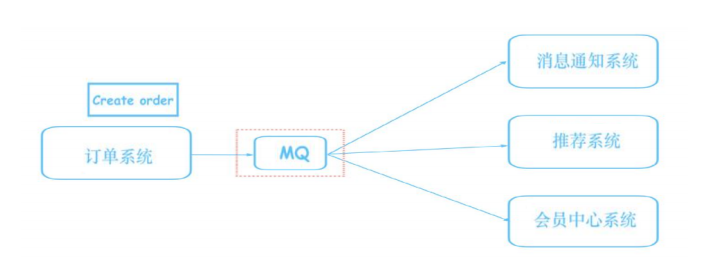
5. Example:
Xiao Hong hopes Xiao Ming can read more books
,
Often look for good books for Xiao Ming
,
The previous way was like this: Xiao Hong asked Xiao Ming when he was free
,
Send the book to Xiao Ming
,
And personally supervise Xiao Ming to leave after reading the book
.
in the course of time
,
Both felt in trouble
.
Later, the method was changed to: Xiao Hong said to Xiao Ming, "you should read all the books I put on the shelf."
,
Then every time Xiao Hong finds a good book, she puts it on the shelf
,
Xiao Ming took it down to read when he saw a book on the shelf
The bookshelf is a message queue. Xiaohong is a producer and Xiaoming is a consumer
.
①. Benefits
(1).
When Xiao Hong wants to give Xiao Ming a Book
,
Don't ask Xiao Ming when he is free
,
I handed him the book myself
,
Xiao Hong just put the book on the shelf
.
In this way, Xiao Hong and Xiao Ming have more free time
.
(2).
Xiao Hong believes in Xiao Ming's reading consciousness and reading ability
,
You don't have to observe Xiao Ming's reading process with your own eyes
,
Xiao Hong just needs to do an action of putting the book
,
It saves time
.
(3).
When another reading partner Xiaoqiang joins in tomorrow
,
Xiao Hong still only needs to put the books on the shelf
,
Xiao Ming and Xiao Qiang can take books from the bookshelf
(4).
Where are the books on the shelf
,
Xiao Ming reads fast and finishes it early
,
If you read slowly, you'll finish it later
,
No problem
,
Compared with the way Xiao Hong handed the book to Xiao Ming and supervised Xiao Ming to finish reading it
,
Xiao Ming will feel less pressure
.
②. Message queue characteristics
(1).
decoupling
:
Each member does not have to be affected by other members
,
Can be more independent
,
Only through a simple container to contact
.
(2).
increase speed
:
Xiao Hongxuan just needs to do an action of putting the book
,
Save yourself a lot of time
.
(3).
radio broadcast
:
Xiao Hong only needs to work once
,
You can make multiple small partners have books to read
,
This greatly saved her time
,
It also makes the joining cost of new small partners very low
.
④.
Peak shifting and flow control
:
The frequency of Xiaohong's books is unstable
,
If you give five copies today and tomorrow
,
Then I gave another one every three months
,
Xiao Ming only needs to take five books from the bookshelf and finish reading them in three months
,
The pressure is not so great
.
6.Email case:
A large number of users have registered your software
,
In the case of high concurrency, some problems begin to appear in the registration request
.
For example, the mail interface can't bear it
,
Or a lot of calculations when analyzing information
cpu
the full load
,
This will happen, although user data records will soon be added to the database
,
But it's stuck when sending e-mail or analyzing information
.
Resulting in a significant increase in request response time
,
Even timeout
,
This is a little uneconomical
.
In this case, these operations are generally put into the message queue
(
Producer consumer model
),
The message queue is processed slowly
,
At the same time, you can complete the registration quickly. Please
seek
,
It will not affect users' use of other functions
.
7.AMQP
An application layer standard advanced message queuing protocol providing unified messaging service
,
Is a general application layer protocol
Both sending and receiving sides of messages can realize asynchronous communication by abiding by this protocol
.
This protocol specifies the format and working mode of the message
8. Technical selection
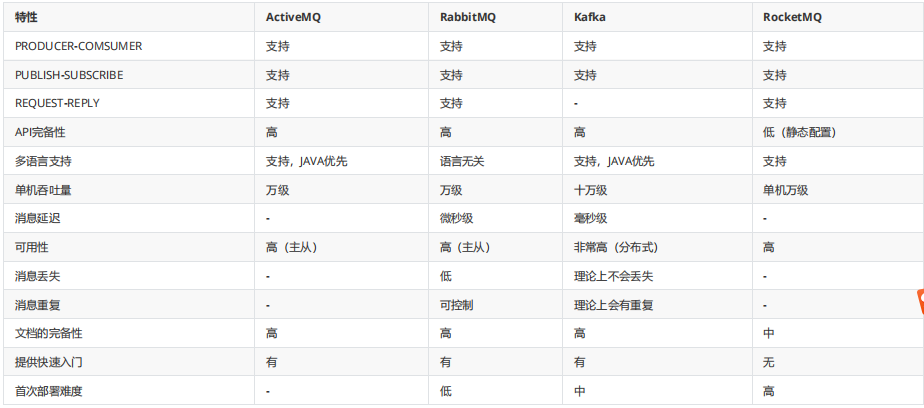
9.RabbitMq
RabbitMQ
It's a realization
AMQP(Advanced Message Queuing Protocol)
Message Queuing service of advanced message queuing protocol
,
use
Erlang
language
.

Server(Broker):
Receive client connections
,
realization
AMQP
The process of message queuing and routing function of the protocol
.
Virtual Host
: concept of virtual host
,
Similar permission control group
,
One
Virtual Host
There can be more than one in the
Exchange
and
Queue.
Exchange:
Switch
,
Receive messages from producers
,
And according to
Routing Key
Route messages to queues in the server
Queue.
ExchangeType:
The switch type determines the routing message behavior
,RabbitMQ
There are three types of
Exchange,
namely
fanout
,
direct
,
topic.
Message Queue
: Message Queuing
,
Used to store messages that have not been consumed by consumers
.
Message
: by
Header
and
body
form
,Header
Is a collection of various attributes added by the producer
,
include
Message
Whether it is persisted, what is the priority and by which
Message Queue
Receiving, etc
.body
Is the data that really needs to be sent
Allow
.
BindingKey
: binding keywords
,
Put a specific
Exchange
And a specific
Queue
Bind
.
II Docker installation and deployment RabbitMQ
1.
docker pull rabbitmq
:
management
Pay attention to obtain the image when obtaining the image
management
Version
,
Don't get
last
Version
,management
Version management interface
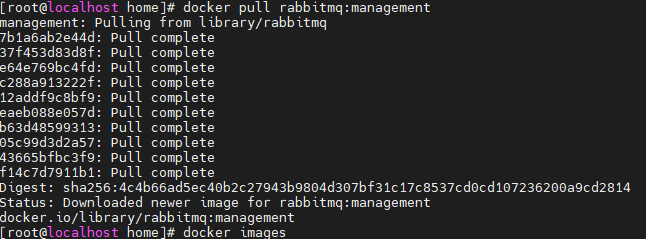
2.
docker run
-
d \
--
name my
-
rabbitmq \
-
p
5672
:
5672
-
p
15672
:
15672
\
-
v
/
home
/
rabbitmq
:
/
var
/
lib
/
rabbitmq \
--
hostname my
-
rabbitmq
-
host \
-
e RABBITMQ_DEFAULT_VHOST
=
my_vhost \
-
e RABBITMQ_DEFAULT_USER
=
admin \
-
e RABBITMQ_DEFAULT_PASS
=
admin \
--
restart
=
always \
rabbitmq
:
management
--hostname
: hostname
(RabbitMQ
An important note is that it is based on the so-called
"
Node name
"
Store data
,
The default is the host name
)
-e
: specify environment variables
:
RABBITMQ_DEFAULT_VHOST
: default virtual machine name
RABBITMQ_DEFAULT_USER
: default user name
RABBITMQ_DEFAULT_PASS
: password for default user name

After the container is started, you can view the logs through the docker logs container
docker logs my
-
rabbitmq
Enter the management background
http://ip:15672

III springboot connection configuration
1. Configure account

Remember that authorization is required
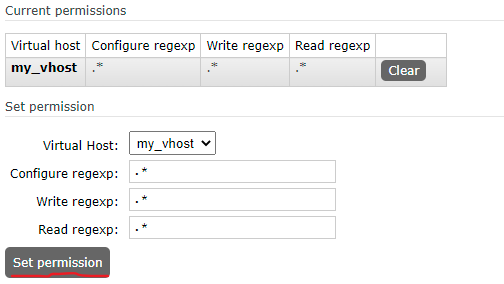
2.springboot project construction

3. Required dependencies
<
dependency
>
<
groupId
>
org
.
springframework
.
boot
</
groupId
>
<
artifactId
>
spring
-
boot
-
starter
-
amqp
</
artifactId
>
</
dependency
>
4.yml file configuration
server:
port: 8080
spring:
application:
name: xx
rabbitmq:
#Virtual machine id
host: 192.168.208.137
password: admin
port: 5672
username: springboot
virtual-host: my_vhost
5. Producer Provider
①.RabbitConfig
package com.example.demo;
import org.springframework.amqp.core.Queue;
import org.springframework.context.annotation.Bean;
import org.springframework.context.annotation.Configuration;
@Configuration
@SuppressWarnings("all")
public class RabbitConfig {
@Bean
public Queue firstQueue() {
return new Queue("firstQueue");
}
}②.Sender
package com.example.demo;
import org.springframework.amqp.core.AmqpTemplate;
import org.springframework.beans.factory.annotation.Autowired;
import org.springframework.stereotype.Component;
@Component
@SuppressWarnings("all")
public class Sender {
@Autowired
private AmqpTemplate rabbitTemplate;
public void sendFirst() {
rabbitTemplate.convertAndSend("firstQueue", "Hello World");
}
}
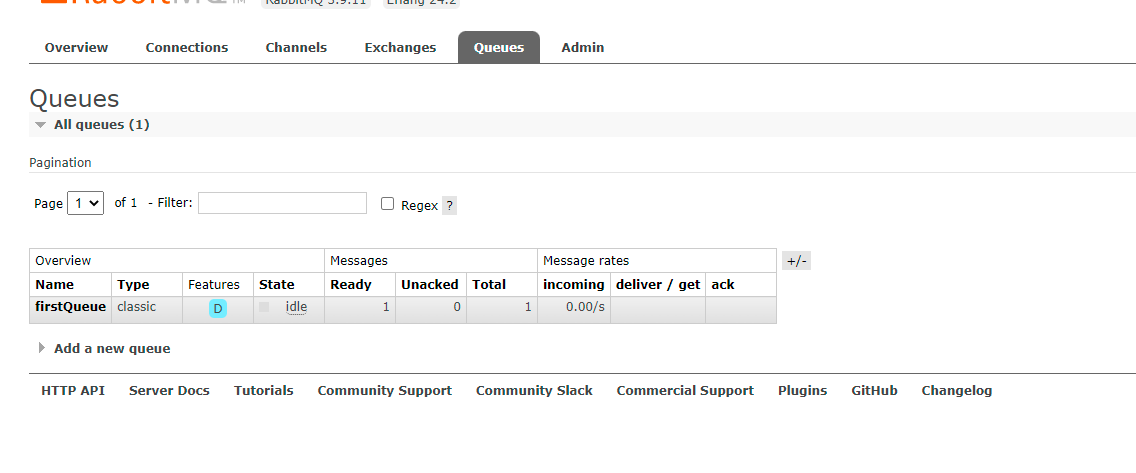
If there is a report: Java lang.IllegalStateException: Found multiple @SpringBootConfiguration annotated classes
Just comment out the @ SpringBootApplication annotation on the pojo project startup class.
6. Consumer
①.Receiver
package com.example.demo;
import lombok.extern.slf4j.Slf4j;
import org.springframework.amqp.rabbit.annotation.RabbitHandler;
import org.springframework.amqp.rabbit.annotation.RabbitListener;
import org.springframework.stereotype.Component;
@Component
@SuppressWarnings("all")
@Slf4j
@RabbitListener(queues = "firstQueue")
public class Receiver {
@RabbitHandler
public void process(String msg) {
log.warn("Received:" + msg);
}
}7. Custom data sending
package com.example.demo;
import lombok.AllArgsConstructor;
import lombok.Data;
import lombok.NoArgsConstructor;
import java.io.Serializable;
@SuppressWarnings("all")
@Data
@AllArgsConstructor
@NoArgsConstructor
public class User implements Serializable {
private String username;
private String userpwd;
}
package com.example.demo;
import com.fasterxml.jackson.databind.ObjectMapper;
import lombok.SneakyThrows;
import org.junit.jupiter.api.Test;
import org.springframework.beans.factory.annotation.Autowired;
import org.springframework.boot.test.context.SpringBootTest;
@SpringBootTest
class ProviderApplicationTests {
@Autowired
private Sender sender;
@Test
@SneakyThrows
void contextLoads() {
//sender.sendFirst(new User("shadow", "123");
User user=new User("yingz","123");
ObjectMapper mapper=new ObjectMapper();
sender.sendFirst(mapper.writeValueAsString(user));
}
}
public void sendFirst(String json) {
rabbitTemplate.convertAndSend("firstQueue", json);
}package com.example.demo;
import com.fasterxml.jackson.databind.ObjectMapper;
import lombok.SneakyThrows;
import lombok.extern.slf4j.Slf4j;
import org.springframework.amqp.rabbit.annotation.RabbitHandler;
import org.springframework.amqp.rabbit.annotation.RabbitListener;
import org.springframework.stereotype.Component;
@Component
@SuppressWarnings("all")
@Slf4j
@RabbitListener(queues = "firstQueue")
public class Receiver {
@RabbitHandler
@SneakyThrows
public void process(String json) {
log.warn("Got it:" + json);
ObjectMapper mapper=new ObjectMapper();
log.warn("Received:" + mapper.readValue(json,User.class));
}
}